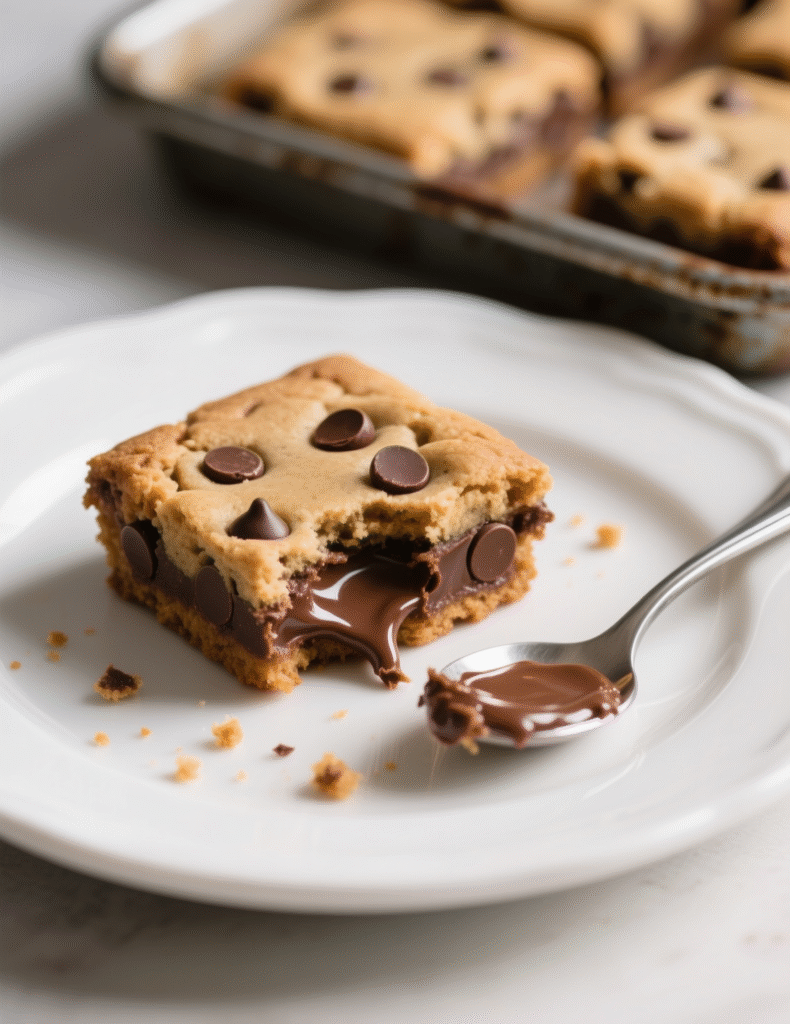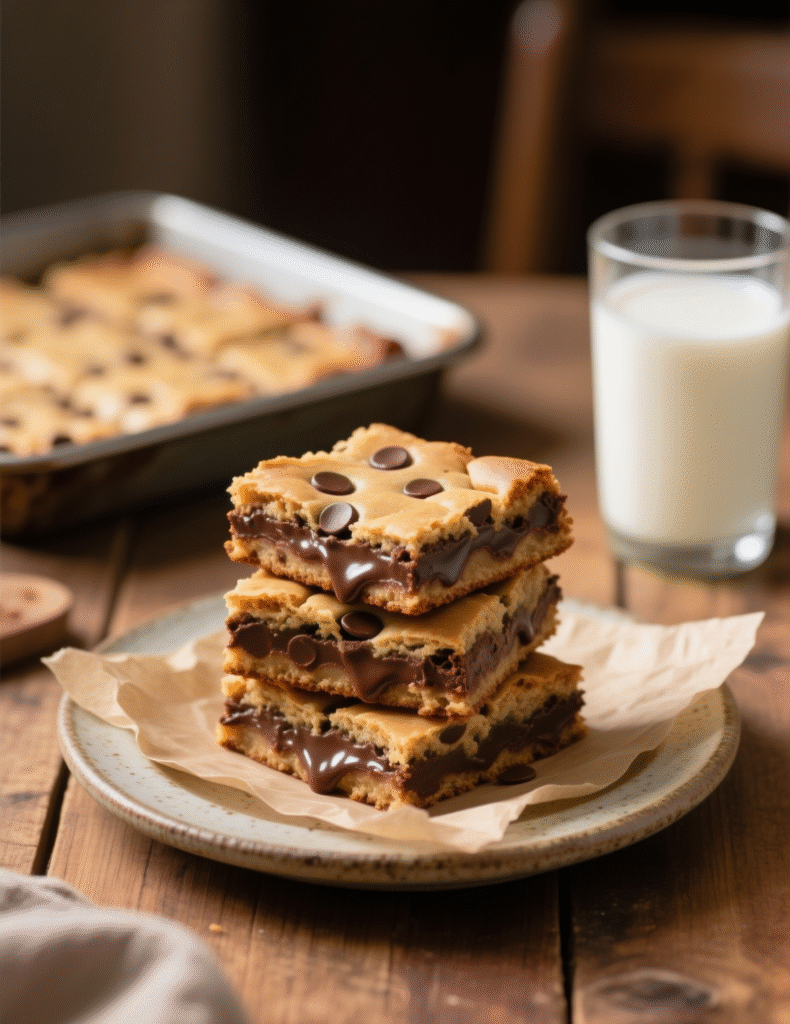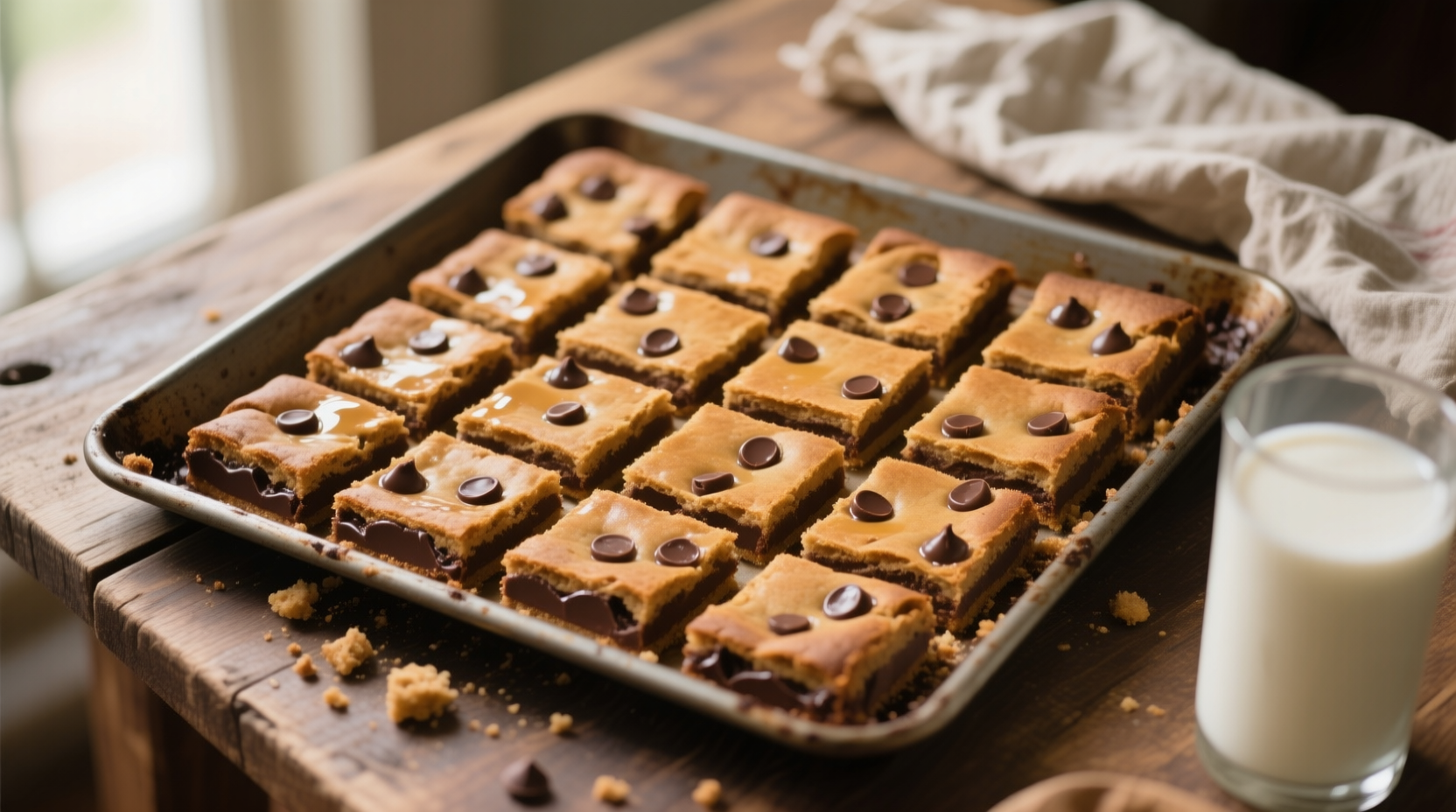The truth is, cookie bars don’t get enough credit. Everyone talks about chocolate chip cookies, the iconic ones that sit on bakery shelves. But when you’re craving the exact same flavors with half the fuss, lazy chocolate chip cookie bars are the champion nobody’s really celebrating enough.
These bars bring that gooey, chewy, crisp-on-the-edge magic without scooping a single dough ball. They’re practical, they’re versatile, and yes—they can even be gourmet if you know what you’re doing. My goal here is to take something that looks dead simple and show you why it deserves expert attention.
Why Cookie Bars Beat the Classic Cookie Sometimes
Traditional chocolate chip cookies require portioning, chilling, rotating trays, and constant oven babysitting. Bars strip all that away. Mix, spread, bake. That’s the whole cycle.
For a professional kitchen, that simplicity translates into efficiency. One sheet pan gives you 24 uniform bars in under 35 minutes, compared to the 45+ minutes needed for multiple cookie trays. Restaurants that serve casual desserts often lean on bars precisely because of this time-to-yield advantage.
And for the home baker? You can throw the dough together after dinner and still be on the couch before the credits of your favorite show start rolling. It’s not laziness—it’s smart baking economics.
Understanding the Base Formula
At its core, the dough isn’t far from the Toll House classic. Flour, butter, sugar (both white and brown, always), eggs, baking soda, salt, and chocolate chips. What changes is the ratio and the handling.
A bar dough tends to be slightly drier than drop cookies. Why? Because spreading dough across a pan means less evaporation surface during baking. If you keep the hydration too high, the bars collapse into greasy mush. The balance comes from upping the flour just a touch, often 1/4 cup more than your standard cookie formula.
Professionals also know the trick of using melted butter instead of creamed butter. It eliminates air pockets, giving the bars a denser, fudgy structure instead of puffed cookie domes.
Choosing the Right Chocolate
The word “lazy” shouldn’t fool you into thinking the chocolate can be cheap. It’s still the ingredient that decides whether your bars taste nostalgic or unforgettable.
Semi-sweet chips are the baseline. But if you’re baking for adults, chopping a 70% dark chocolate bar into uneven chunks creates a rustic spread of pools and shards. Milk chocolate is softer, sweeter, and pairs beautifully with sea salt sprinkled on top. White chocolate with macadamia turns the bar into something closer to a café treat.
Research from Barry Callebaut shows that consumer preference for “texture diversity” in chocolate is rising each year. That’s another reason to ditch uniform chips and introduce chopped couverture.

Mixing: The Lazy Baker’s Dilemma
You’ll see debates online—hand mix or stand mixer? For lazy bars, hand mixing wins nine times out of ten. The melted butter base means everything comes together with a wooden spoon in under 2 minutes. Over-mixing in a stand mixer risks tough gluten strands, which give you stiff bars instead of chewy ones.
I’ve tested both methods in a bakery setting. For large batches, yes, mixers save time. But for home or small cafés, a single bowl and spoon technique produces better texture and, honestly, fewer dishes.
Pan Size and Its Sneaky Influence
This part gets overlooked, but pan size completely transforms the outcome. An 8×8 pan yields thick, brownie-like bars that need 35 minutes at 350°F. A 9×13 gives thinner, crispier edges and a 25-minute bake.
Glass pans bake slower but allow even heat distribution. Metal pans crisp the edges faster, which some argue is the best bite of any cookie bar. Professional pastry chefs often line with parchment for clean removal—skip greasing the sides or your bars climb up and sink awkwardly.
Lazy Doesn’t Mean Flavorless: Enhancements
Even the so-called lazy version has room for artistry. A teaspoon of espresso powder intensifies the chocolate. Brown butter in place of melted butter adds a nutty depth that tricks people into thinking you spent hours perfecting the recipe.
I’ve also tested folding in toasted nuts, coconut flakes, and even crushed potato chips for a sweet-salty surprise. Market research shows that 54% of U.S. consumers actively seek “novel texture” in desserts—so why not let the bar be your canvas?
The Science of Bake Time
Cookie bars are sneaky. They often look done before they are. The center jiggles, edges firm, and people pull them too early, thinking they’ll firm up like brownies. But unlike brownies, bars need that extra 3–5 minutes for structure.
Pulling them at 25 minutes in a thick pan means raw centers by the time they cool. I recommend testing with a toothpick near the middle—not for dryness but for wet crumbs. If it’s liquid batter, you’re not there yet. If it’s gooey crumbs, that’s perfect.
Professional bakers also know that carryover heat is your ally. The bars finish cooking out of the oven, so resist the urge to cut immediately. Cooling for at least 30 minutes helps them set without crumbling apart.
Storage and Shelf Life
Bars have a slight advantage over cookies here. The density and thickness hold moisture longer, giving you 3–4 days of freshness at room temp compared to 2–3 days for cookies. Wrap tightly or store in an airtight container.
For bakeries, that extended shelf life is valuable. A tray can be baked in the morning and sold across multiple days without losing quality. Freeze them in slabs, too—they thaw well and taste almost identical to fresh.
Common Mistakes to Avoid
Adding too much flour is the number one mistake. People panic when the batter looks glossy, forgetting it thickens as it cools. Over-baking is the second. Dry bars are sad bars, and once they cross that line, no amount of milk saves them.
Another? Using margarine instead of butter. The water content in margarine throws off the fat balance, leaving you with rubbery bars. And don’t skip parchment—removing bars from an unlined pan is the kind of regret you don’t forget.
A Professional Twist: Service Ideas
Cookie bars don’t have to be rustic tray bakes. Professionals elevate them with plating. Warm a square, top with vanilla bean ice cream, drizzle with salted caramel. Or cut into bite-sized cubes and serve on dessert boards alongside fruit and cheeses.
In coffee shops, I’ve seen bakers wrap diagonal halves in wax paper for a trendy, handheld snack. One café in Portland boosted bar sales 40% by cutting smaller squares and selling them as “lunchbox packs.” Sometimes presentation is the only thing between ordinary and exceptional.

Variations That Keep the Formula Fresh
S’mores version: swap half the flour for crushed graham crackers, mix in marshmallows and dark chocolate.
Peanut butter swirl: dollop warmed peanut butter on top of the dough, drag a knife through before baking.
Holiday style: add crushed candy canes in December or pastel M&Ms for Easter.
What’s nice about the lazy bar format is its adaptability. Once you master the base, the possibilities are nearly endless.
Lazy Yet Luxurious: Brown Butter Recipe
Here’s my go-to upscale version:
- 1 cup unsalted butter, browned and cooled slightly
- 1 cup brown sugar + 1/2 cup white sugar
- 2 large eggs + 1 yolk
- 2 tsp vanilla extract
- 2 1/4 cups all-purpose flour
- 1 tsp baking soda
- 1/2 tsp kosher salt
- 2 cups chopped dark chocolate
Mix butter and sugars, whisk in eggs and vanilla. Fold in dry ingredients. Spread into 9×13, bake at 350°F for 27 minutes. Sprinkle with flaky salt as soon as it comes out. These taste like the expensive bakery treat people line up for.
Answering the Big Question: Are They Really Lazy?
Yes, but in the best possible way. Lazy in the sense that the method strips away fuss. Not lazy in the flavor or the creativity. Even professionals lean on “lazy” methods when efficiency is the goal—think sheet-pan dinners or one-pot stews.
The cookie bar fits neatly into this philosophy. Maximum payoff, minimum steps. That’s not laziness. That’s smart cooking.
Conclusion: Why You Should Bake Them Tonight
Lazy chocolate chip cookie bars aren’t just a shortcut. They’re a professional’s trick, a home baker’s weeknight savior, and a kid’s after-school dream. They balance nostalgia with practicality, tradition with innovation.
If you’re a professional, they save labor and boost consistency. If you’re a hobbyist, they reward you with chewy chocolate bliss without the headache. And if you’re just someone craving cookies but unwilling to babysit a tray—these bars are waiting.
Bake them once and you’ll see. The lazy cookie bar isn’t a compromise. It’s a clever evolution of a classic.
FAQs
What makes lazy chocolate chip cookie bars different from regular cookies?
They skip scooping dough balls and bake as one slab, making them faster and easier.
Can I use margarine instead of butter in cookie bars?
No, margarine adds too much water and makes the bars rubbery.
How do I know when the cookie bars are done baking?
Look for set edges and a toothpick with moist crumbs, not raw batter.
Which pan is best for baking cookie bars?
A metal pan gives crispier edges, while glass bakes more evenly but slower.
Can I add mix-ins besides chocolate chips?
Yes, nuts, coconut, marshmallows, or even candy work beautifully.
How long do cookie bars stay fresh?
They last about 3–4 days at room temperature when stored airtight.
Can I freeze chocolate chip cookie bars?
Absolutely, they freeze well and taste almost the same when thawed.
Do I need parchment paper for cookie bars?
Yes, it prevents sticking and makes removing bars much easier.
Why do professionals prefer bars in bakeries?
They’re efficient—one batch yields uniform portions with less labor.
Can I make cookie bars gluten-free?
Yes, just swap all-purpose flour with a 1:1 gluten-free baking blend.

Mariana is a passionate home cook who creates delicious, easy-to-follow recipes for busy people. From energizing breakfasts to satisfying dinners and indulgent desserts, her dishes are designed to fuel both your body and hustle.
When she’s not in the kitchen, she’s exploring new flavors and dreaming up her next recipe to share with the Foodie Hustle community.

